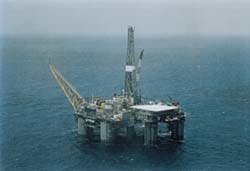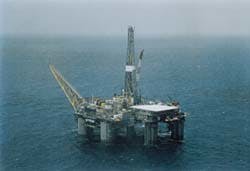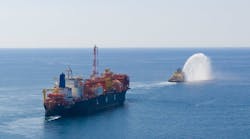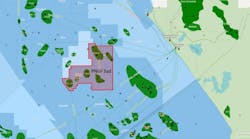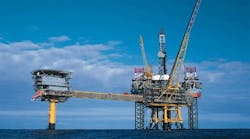Peter Behrenbruch
BHP Petroleum
Enserch's Garden Banks 388 floating production unit (not storage), along with Petrobras' new Marlim production semisubmersibles, continue to push the limits for mooring spreads.
- Thirteen different FPSO mooring configurations,derived from four basic units, are in use today. (Source: Behrenbruch, modified after Goodfellow)
- Table:Geographical distribution of floating production facilities.
- Table:Applications of floating production facilities.
- Table:Floating production vessels as a function of water depth.
- Typical FPSO costs (US$million, 1995).
PART II:
This article is the second of a two-part series on the development of the monhull and semisubmersible floating production systems. Part I appeared in the October issue.
There are four key selection and design criteria for floating production systems which generally are most important in determining the choice of facilities. They are hydrocarbon reserves, number of wells, water depth, and existing infrastructure.
First, there is the choice between floating facilities and other alternatives. More generally, the following needs to be considered:
- Reservoir aspects (reserves, productivity).
- Well plan (wells - number, location and type).
- Environmental factors (water depth, weather, ocean and soil conditions).
- Distance to infrastructure (other facilities or pipeline, distance from offshore or island).
- Type of fluids and export requirements.
- Prior experience and already existing production vessels that are available for purchase or hire.
Reservoir aspects
In case of floating facilities, the most important aspect often tends to be the reserves size of a field. In many cases, floating facilities are used when reserves are marginal.
If doubt exists about reserves or reservoir complexity, extended well tests or early production facilities have often preceded final field development.
Furthermore, floating facilities in combination with subsea wells are most advantageous for simple field situations, requiring few wells. For example, BP designed the dynamically positionedFPSO Seillean (Swops I) specifically to produce reservoirs which, although small, are geologically simple with good productivity characteristics and aquifer support (e.g. Cyrus Field, North Sea).
A second aspect is areal field extent. Although floating facilities are not as restricted as platform developments, particularly for shallow reservoir situations, a compact field of reasonable vertical thickness is desirable in that the development of such a field is less expensive. Floating facilities may also have an edge in cases where several small fields are present in a radius of say up to 20 km, too extensive for efficient platform development.
Vessel type
The first choice to be made is between a FPSO and a FPU, where the former tends to be used more often in remote areas where little or no infrastructure exists. Another consideration may be an opportunity to acquire an already existing vessel which would accelerate the schedule to first oil.
Semisubmersibles have been primarily used in the Campos basin offshore Brazil and the North Sea, areas where ample pipeline infrastructure exists. In Brazil, there has also been a need to locate facilities in ever deeper waters.
FPSOs are then the most attractive offshore facilities for marginal and small fields in remote waters and have been utilized in almost every part of the world. Their relatively low operating cost, coupled with easy re-use potential, have given these facilities the economical edge.
Another deciding factor between utilizing a FPSO or FPU is the number of wells to be accommodated and the total throughput of fluids which in case of a FPSO usually have to pass through fluid swivels, and may put restrictions on the use of FPSO facilities. However, such limitations have largely been removed with the advent of internal turrets. On the other hand, a drawback in utilizing semisubmersibles has at times been space and weight limitations on the FPU, particularly when fluid injection/gas export etc. is an additional requirement.
Finally, there is the consideration of overall environmental state as related to ocean and weather conditions. This aspect not only impacts the decision in selecting the type of vessel but also the mooring arrangement.
Mooring arrangements
Mooring arrangements for semisubmersible facilities tend to be relatively simple in that the facility tends to be permanently moored using 4-12 chains emanating from the corners of the vessel. Dynamic motion analysis for expected environmental conditions will indicate the mooring forces to be expected and hence will determine the holding power in terms of number of mooring chains, their size, and the anchor requirements.
Early mooring designs for FPSOs had their origin with tanker offloading systems, initially being of relatively simple design: CALM and SALS type. Environmental conditions tend to vary considerably by region and may be accommodated in a number of different ways. In severe situations, the mooring system may either be of the disconnectable type or, more recently, central turret designs have been an alternative means to design for more onerous situations.
In the former case, the vessel is simply disconnected for a severe storm situation. This type of design is particularly advantageous for tropical waters where average environmental conditions are benign or moderate most of the time. In the unlikely event of a severe storm passing close to the facility, the powered FPSO disconnects from its mooring, moving either out of the vicinity or weathering out the storm in a disconnectable state. Reconnection to the mooring will then take place when wave action has diminished below a certain threshold. As this reconnect criterion, in terms of wave height, is usually substantially more stringent than the disconnect criterion, the disconnectable mooring design is unsuitable in waters which experience considerable wave action most of the time. The latter situation may lead to appreciable downtime due to the vessel not being able to reconnect to its mooring. Furthermore, the impact of environmental conditions on mooring loads translates also into costs.
In most instances, an alternative is to design a fixed system utilizing a central internal turret(Petrojarl, Tentech), preferably with assistance of thrusters (DP). Another recent design is to use an internal buoyant turret which is disconnectable. Permanently moored, central turret ship-shape vessels closely mimic a semisubmersible with storage, but the former appear to be more economical at this stage as converted tankers are more often second hand rather than new-built vessels. This type of turret design is then also ideally suited for deep water situations and there are several deep water fields to be developed over the next 2 -3 years using this type of design.
Deepwater developments
The premier deep water area is Brazil's Campos basin where oil reserves of over 3 billion barrels are located in water depths of 400-1,000 meters and over 2 billion bbl of oil reserves are located in water greater than 1,000 meters.
Currently, there are more than a dozen FPSs operating in this basin, located in water depth ranging from 100 meters to more than 900 meters. Petrobras, the operator, also holds the record for the deepest (guidelineless) subsea completion, 1027 meters in the Marlim field. Except for theFPSO Presidente Prudente de Moraes, the other FPSs are all of the semisubmersible type, as there is considerable infrastructure of existing pipelines and fixed platforms. It should be noted that the recently completed new-built semisubmersible (Petrobras XVIII), is the largest of its type.
There are also a number of other deep water areas where FPSs are being used or may have a future in the short term: the Gulf of Mexico, the North Sea (UKCS and Norwegian CS) and even the Mediterranean. At least two FPSOs are to be installed in Northern Europe in water depths greater than 300 meters and Enserch's Garden Banks 338 development may just be the first of several possible developments, including some of Shell's deepwater discoveries. Not to be forgotten, Placid's earlier development (1987 - 88) in Green Canyon 29 proved up the feasibility of deepwater production (468 meters) in the Gulf of Mexico. The most innovative part of that facility was its self-supporting rigid, self-buoyant riser (by Cameron). This unique riser is to be re-deployed for Enserch's Garden Banks development.
And what water depth could ultimately be reached with an FPSO? Most experts believe 2,000 meters should definitely be feasible and 3,000 meters may eventually be a requirement. For these applications, semisubmersibles would be well placed when a moderate number of subsea wells (10 - 20) are required and even central turret FPSOs are likely to prove up to be an acceptable alternative. For larger well numbers, compliant towers (more conceptual) or tension leg platforms (TLPs) may have an edge. There are currently seven of the latter facilities in operation, being constructed or under consideration: Hutton, Snorre and Heidrun (North Sea); and Jolliet, Auger, Mars and Ram-Powell (GOM).
The drawback of TLPs is the relatively longer lead time and expense when compared with semisubmersible based facilities. One solution may be to utilize a semisubmersible in combination with simple wellhead TLPs.
Australian FPSO's
Australia's first offshore petroleum success commenced with the discovery of hydrocarbons beneath Barrow Island, offshore Western Australia, in July 1964. On a much larger scale the Gippsland fields in Bass Strait were discovered in the second half of the 1960's. The most recent phase has often involved the development of smaller offshore fields, commencing in 1985 and requiring more innovative offshore facilities. These more unconventional developments have been targeted in remote waters in the north and north-western part of the continental shelf of Australia, utilizing FPSO facilities. Each of these facilities has recorded a number of innovations.
- Located in the Timor Sea, the first development, Jabiru, came on stream in August of 1986 with just 12 million bbl of initial oil reserves (at the time the development decision was made). This meant that capital expenditure was fairly limited. Furthermore, only one of four appraisal wells (Jabiru 1A) had shown promising potential and the field was located in 110 meters of water without any existing infrastructure.
The facilities engineers at BHP Petroleum took a hard look at the options and there were very few with such small reserves. The final decision was to convert a used tanker into a FPSO facility utilizing the world's first disconnectable riser turret mooring (RTM) unit. The cost for this offshore development was just A$70 million, excluding the drilling of the first well). As there was some perceived upside, the mooring-riser was designed to handle up to four wells. This additional flexibility paid off and four wells have been producing for most of the time. The field reached a maximum of 55,000 b/d in 1989/90 and has produced over 85 million bbl to date.
- The second development, Talisman, was perhaps perceived to be even more marginal. There was considerable doubt concerning the commerciality of the discovery and in 1989, Marathon decided to charter theFPSO Acqua Blu for an extended well test, with the option to continue production of the field if sufficient reserves were present. The Acqua Blu was a well seasoned vessel having been on other projects previously. The mooring was relatively simple, being a type of CALM with a stand-off device to prevent the tanker from ramming the buoy. Nevertheless, the project proved successful in that about 10 million bbl were produced over three years, utilizing two subsea wells.
- Another field, Challis-Cassini, was located too far from Jabiru to be tied to the latter using more conventional methods. Furthermore, the riser/processing capacity at Jabiru was limited and was required for that field. Based on initial reserves of 23 million bbl, the decision was made by the joint venture (BHP Petroleum as operator) to utilize another FPSO facility. In 1987 the used tanker market was, however, considerably less attractive when compared to building a new vessel (shipyards were not too busy), resulting in the decision to construct a new vessel (no propulsion).
Based on the experience gained at Jabiru, where additional riser slots would have been advantageous, and based on the prospectivity of the Challis area, a new mooring riser concept was designed, resulting in the world's largest fixed riser. A solid anchor leg, rigid arm mooring (SALRAM) was connected to a new-built barge. The riser system was able to accommodate up to 10 wells and up to four tie-ins of possible neighboring accumulations. The riser had a diameter of 10.5 meters and weighed 3,000 tonnes (dry), close to a practical limit. To date, the field has produced over 40 million bbl, including subsea production from the satellite accumulation, Cassini. The project was also successful in utilizing gravel-packed, multi-zone completions and water injection in one well. The initial cost of the development was A$230 million.
The fourth field, the third in the Timor Sea (BHP Petroleum as operator), was very different from a reservoir point of view in that it contained a gas cap (about 10% gas cap reservoir volume to oil leg reservoir volume). Furthermore, the field appeared lithologically more complex than either Jabiru or Challis. Reserves were also marginal and not many wells could be afforded. To compound matters, a number of surprises were experienced during the project implementation stage. The interpretation of a 3D seismic survey (while a second-hand tanker was in the yard for conversion) saw reserves plummet from the original 25-30 million bbl to a level of around 10 million bbl.
Furthermore, drilling of the first appraisal well met with geological surprises which led to the decision to abandon the use of the planned horizontal wells. At this stage, the entire project was in jeopardy. However, perseverance with the project not only proved up sufficient reserves but also that the reservoir plan of targeting just three wells crestally, blowing down the primary gas cap, worked according to prediction. This policy, planned from the onset of production, is believed to be unique.
On the facilities engineering side, more innovative features were the use of an opto-electrical system to transmit control and instrumentation signals across the swivels, and the use of a natural gas liquids (NGL) recovery plant. The field has produced more than 18 million bbl to date and the payout of the initial capital investment of A$180 million was in the end easily achieved. The facility arrangement is similar as for Jabiru where a converted tanker is moored using a disconnectable riser turret.
- The latest FPSO project to come on stream is the Griffin field (BHP Petroleum as operator), located on the Northwest Shelf in 130 meters of water. The project utilizes a new-built vessel and also a disconnectable riser turret mooring. Production commenced in January of 1994, building up to the planned rate of 80,000 b/d which has been maintained to date. The riser turret was designed to initially accept a total of 11 wells (expandable to 15) and the swivels are also designed for gas export by pipeline to shore and gas re-injection into the reservoir. The subsea arrangement uses the concept of paired wells (common distribution skid). An electrohydraulic multiplexed control system is used to permit the larger number of wells to be accommodated by the mooring. On the subsurface side, sinusoidal (one and a half cycle) horizontal wells are used for greater productivity and oil recovery from some of the poorer reservoirs.
- The last Australian project to be mentioned is the Wannaea-Cossack development (Woodside is operator), due on stream the second half of this year. The estimated 200 million bbl plus oil reserves are situated at a distance of 33 km from North Rankin-A, the first platform of the large Northwest Shelf gas development. In evaluating alternative development options, it was found that a FPSO facility was economically more attractive than other fixed and floating production systems. The vessel will be moored to a disconnectable riser turret mooring. In terms of process capacity, this will be the largest floating facility offshore Australia, 115,000 b/d. Gas export will be to North Rankin-A.
Semisubmersible case
The first semisubmersible FPU (North Sea Pioneer, Transworld-58 design) was deployed by Hamilton in the North Sea in June 1975. This innovative development (utilizing initially four wells) at a cost of just US$68 million was well suited to develop the marginal Argyll field which was perceived to be geologically complex.
This new style of development thus not only brought early cash flow but was also intended to provide a better understanding of the reservoir and help determine if a fixed production platform was justified. Subsea well completions and the use of a FSO were also part of this scheme. Production was via eight rigid 4-in. risers and export via one 10-in. riser, all connected at the top to individual riser tensioners (flexible flowlines were not yet available).
These risers were connected via autolock connectors to the subsea base-manifold located 79 meters directly below the facility. In rough weather, it was necessary to disconnect and retrieve the risers. The first satellite field (Duncan), located 6 km from Argyll, was brought on stream in November 1983 using subsea wells and a seabed manifold.
With the subsequent requirement of water injection for Duncan, and the more limited deck load for the TW-58, a second semisubmersible (Aker H-3) was acquired and modified for service in 1985. The new facility, namedDeepsea Pioneer, was not only capable of processing up to 70,000 bbl/d of oil (the same as the TW-58) but also to inject up to 60,000 b/d of water and gas-lift.
The TW-85 was temporarily re-deployed in January of 1985 for the small Innes field, 13 km from Argyll. This field later produced directly to theDeepsea Pioneer until February of 1991 and the TW-58 was again redeployed, producing briefly from the Crawford field.
By October 1992, production from the Argyll/Duncan fields had declined to 6,000 b/d, the economic limit. The joint venture decided to abandon the field.
The first abandonment phase involved suspension of the wellheads and the removal of theDeepsea Pioneer. Phase 2 involved abandonment of 18 wells, recovery of 70 km of flexible flowlines and 60 km of umbilicals, the mooring systems, subsea manifolds and the CALM loading buoy. The relatively low cost of £20 million for this field abandonment was again the result of innovation, the use of a DP diving support vessel and a specialized flowline cutting machine.
As the chapter was closing on the Argyll/Duncan/Innes fields, theDeepsea Pioneer was available for further action and was acquired by BHP Petroleum and its partners for the Dai Hung field, offshore southern Vietnam (Con Son basin). After a fast-track appraisal/development well program and refurbishment of the semisubmersible (renamed the Dai Hung-1), first oil was achieved just 18 months after signing the production sharing contract (with the Socialist Republic of Vietnam). Production commenced on 14 October of last year, two days ahead of schedule.
The EPS facilities consist of a semisubmersible FPU and a FSO vessel connected to a CALM buoy. The production from four subsea wells (and injection into one well), drilled from three separate surface locations, passes through dual 3-in. subsea flowlines to the floating production unit (FPU). Three of the wells are located under the FPU and the other two wells are located approximately 1.5 km from the FPU. The oil is separated from gas and water on board the FPU and the gas is used for fuel with the remainder flared. The oil is then pumped from the FPU to the FSO vessel where it is stored before offloading to another vessel.
The dual 3-in. flowlines connect each well to the FPU via a mid-depth buoy. This configuration allows for pigging and the circulation of hydrocarbons and displacing the flowline contents with another fluid to avoid possible problems from wax formation during periods of production shut-down. Under normal operation, production will be via both flowlines. Each production flowline is connected to the riser balcony on the FPU. The configuration for the two 6-in. export flowlines is similar.
Costs, economics
More recently, larger fields ( 100 million bbl oil reserves) are being developed with the sole use of floating production technology, in situations where a few years ago a fixed platform would have been the only consideration. Costs for floating facilities, on a relative basis, appear to be decreasing, in particular in the subsea components area. Not only is there more competition (suppliers and construction firms) in these and other specialized areas but costly, innovative designs of the past are now becoming common place.
In considering alternative facilities solutions, operators have shown that in many cases floating facilities tend to be considerably more cost effective than fixed platforms.
There is also a trade-off between capital costs and operating costs. Operating two facilities (FPU/FSO) is more expensive than one (FPSO) but capex may be less for the former. A conversion (tanker or semi) carries less capex than a new-built vessel but will be more expensive to operate. Several vessel refurbishments may be required over the life of the project.
In considering real costs to the project, floating facilities and subsea equipment can also be easily re-used and such options need to be taken into account when considering project economics. With reduced capital exposure, there is also added protection against a downturn in reserves.
Finally, in general, floating facilities often have their greatest attraction due to a very short implementation schedule and hence rapid payback.
Floating facilities are gaining in popularity, not just for their application niche - remote developments, small and marginal fields, early production systems and extended well testing - but more recently also for their economic advantage over other development options in the case of larger fields.
Floating facilities using semi-submersible and ship-based vessels (central turret) are well suited for deep water developments, again being favorably placed in economic terms, particularly when only a moderate number of wells are required.
Copyright 1995 Offshore. All Rights Reserved.
